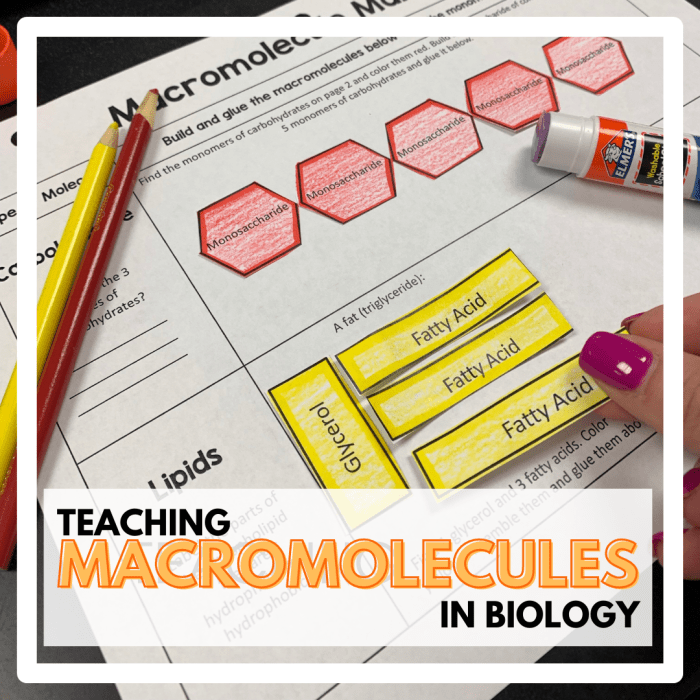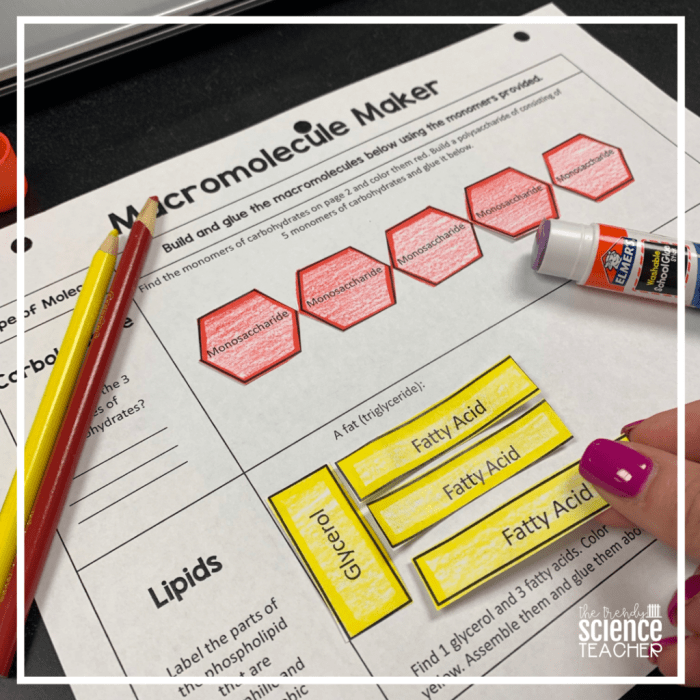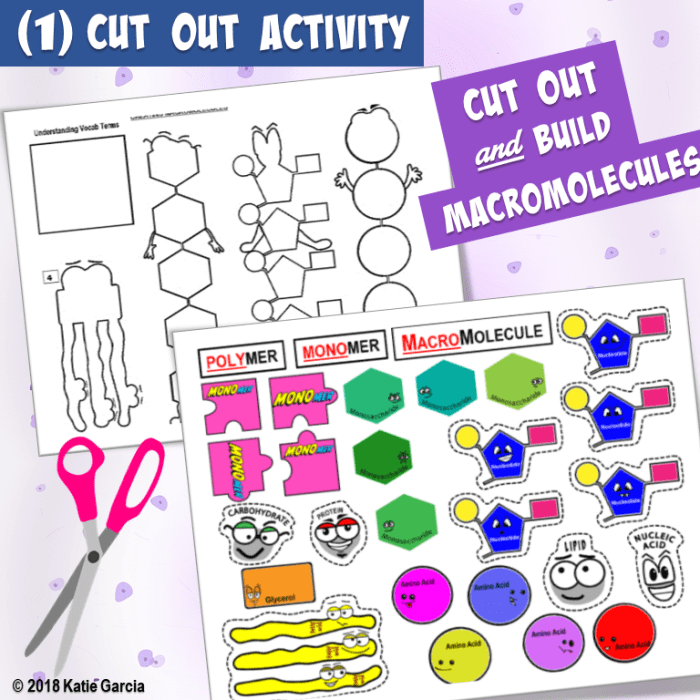Answer key building macromolecules activity answers provide an invaluable resource for students and educators alike, offering a structured approach to understanding the complexities of macromolecules. This comprehensive guide delves into the intricacies of answer keys, exploring their significance in the context of macromolecule building activities.
Answer keys serve as essential tools, guiding learners through the step-by-step process of constructing macromolecules, ensuring accuracy and fostering a deeper comprehension of these vital biological structures.
Key Terms and Concepts
Macromolecules are large, complex molecules that are essential for life. They are composed of smaller molecules called monomers that are linked together by chemical bonds. The four main types of macromolecules are carbohydrates, proteins, lipids, and nucleic acids.
An answer key is a guide that provides the correct answers to a set of questions or problems. In the context of this activity, an answer key for building macromolecules would provide the correct sequence of monomers for each type of macromolecule.
The purpose of an answer key for building macromolecules is to guide students through the process of assembling the correct molecules. It can also help students to learn about the structure and function of different types of macromolecules.
Building Macromolecules: Answer Key Building Macromolecules Activity Answers
To build macromolecules using an answer key, students will need to follow the steps below:
- Read the answer key carefully to identify the correct sequence of monomers for the type of macromolecule that they want to build.
- Gather the necessary monomers and materials.
- Follow the instructions in the answer key to assemble the macromolecule.
- Check their work against the answer key to make sure that they have assembled the correct molecule.
The answer key plays a vital role in the building process by providing students with the correct sequence of monomers. This helps to ensure that students are able to assemble the correct molecules and learn about their structure and function.
Students can use an answer key to build a variety of different types of macromolecules, including carbohydrates, proteins, lipids, and nucleic acids.
Activity Design

The structure and format of an answer key for building macromolecules will vary depending on the specific activity. However, there are some general guidelines that can be followed.
The answer key should be clear, concise, and easy to use. It should provide the correct sequence of monomers for each type of macromolecule, as well as any other necessary information, such as the number of monomers to use or the type of chemical bond to form.
Here are some examples of answer keys for different types of macromolecules:
- Carbohydrates:A glucose molecule is composed of 6 carbon atoms, 12 hydrogen atoms, and 6 oxygen atoms. The monomers of glucose are linked together by glycosidic bonds to form a polysaccharide.
- Proteins:A protein molecule is composed of amino acids. The amino acids are linked together by peptide bonds to form a polypeptide chain.
- Lipids:A lipid molecule is composed of fatty acids and glycerol. The fatty acids are linked together by ester bonds to form a triglyceride.
- Nucleic acids:A nucleic acid molecule is composed of nucleotides. The nucleotides are linked together by phosphodiester bonds to form a polynucleotide chain.
When designing an answer key for building macromolecules, it is important to consider the learning objectives of the activity. The answer key should be designed to help students achieve these objectives.
Benefits of Using an Answer Key

There are several benefits to using an answer key for building macromolecules. These benefits include:
- Accuracy:An answer key helps to ensure that students are able to assemble the correct molecules. This is important for learning about the structure and function of different types of macromolecules.
- Efficiency:An answer key can help students to save time by providing them with the correct sequence of monomers. This allows students to focus on the process of assembling the molecules rather than on trying to figure out the correct sequence.
- Understanding:An answer key can help students to develop a deeper understanding of the structure and function of different types of macromolecules. By seeing the correct sequence of monomers, students can learn about the different types of chemical bonds that are involved in the formation of macromolecules.
Answer keys have been used successfully in a variety of educational settings. For example, answer keys have been used in high school biology classes to help students learn about the structure and function of different types of macromolecules. Answer keys have also been used in college biochemistry classes to help students learn about the synthesis of macromolecules.
Troubleshooting and Tips

If students are having difficulty building macromolecules using an answer key, there are a few things that they can do.
- Check the answer key carefully.Make sure that the answer key is correct and that the students are following the instructions correctly.
- Gather the necessary monomers and materials.Make sure that the students have all of the necessary monomers and materials before they begin building the macromolecules.
- Follow the instructions in the answer key carefully.Make sure that the students are following the instructions in the answer key carefully and that they are not making any mistakes.
- Check their work against the answer key.Once the students have finished building the macromolecules, they should check their work against the answer key to make sure that they have assembled the correct molecules.
Here are some additional tips for making the building process more engaging and interactive:
- Use different colors of monomers.This can help students to visualize the structure of the macromolecules.
- Build the macromolecules in 3D.This can help students to understand the spatial arrangement of the atoms in the molecules.
- Have students present their macromolecules to the class.This can help students to learn about the structure and function of different types of macromolecules and to develop their communication skills.
Helpful Answers
What is the purpose of an answer key for building macromolecules?
Answer keys provide a structured guide for students, ensuring accuracy and fostering a deeper understanding of macromolecule structures and their biological significance.
How can answer keys enhance learning and understanding?
Answer keys facilitate self-assessment, reinforce concepts, and promote critical thinking, leading to improved learning outcomes.
What are some tips for designing effective answer keys?
Effective answer keys should be clear, concise, and easy to use, providing step-by-step instructions and addressing common troubleshooting issues.